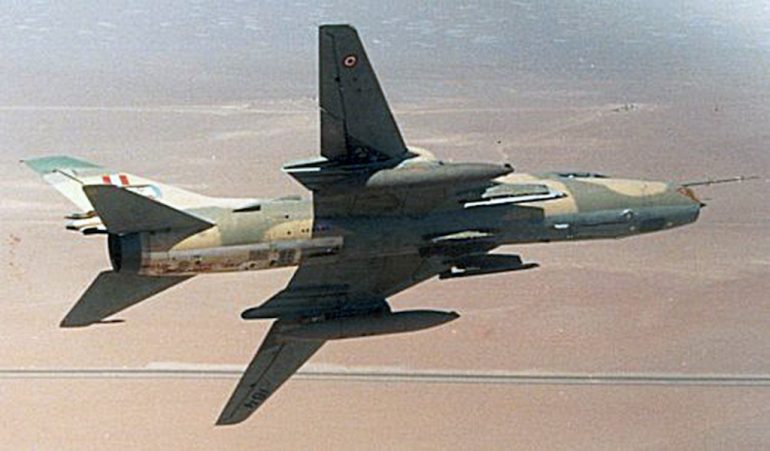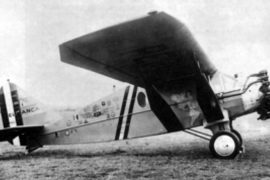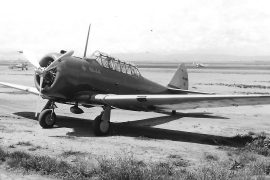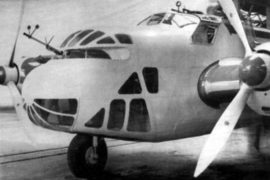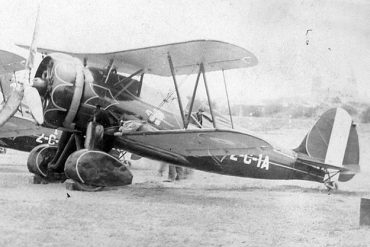By late June, 1977, inhabitants of the fishing town of Talara began to see some strange, sand-colored aircraft, with a short nose, swept wings and an impressive, thunderous sound. These were the first Su-22s that had arrived in Peru and were conducting familiarization flights. Up to that point, these jets were the only Russian-made variable-geometry fighter-bombers operating in South America, something that transformed them immediately into a true landmark of the Peruvian military aviation.
The story of the type with the peruvians hadn’t began then, however. It all had begun five years earlier, when the so-called “Revolutionary Government of the Armed Forces” decided on the modernization of the outdated Peruvian defense systems, which dated back to the 1960s. It was however, that the anti-imperialist policies of the governments of that era were not seen with good eyes by the western powers, and almost no country showed interest in fulfilling the peruvian defense requirements.
The Prime Minister, Gen. Edgardo Mercado Jarrín, after an unsuccessful trip through Western Europe, ended up in Moscow. The former minister recalls that after a few days, the ice was broken and the Soviets organized a demonstration for him in the Black Sea, which included the participation of hundreds of tanks, many aircraft and thousands of soldiers fully equipped for action. In view of the favorable offer –part of the debt could be paid for with fish, flour, copper and iron ores- The peruvian government made the decision of leaving behind its life-long Western arms providers, and to purchase the badly needed modern weapons from the Ural manufacturers.
Preparations for the delivery of 32 factory-new Su-22A Fitter F and four Su-22U Fitter E two-seaters began in 1976; the deal included an unspecified quantity of Tumanski R-29BS-300 engines, S-4 and S-5 rocket pod launchers, air-to-air R-3 “AA-2 Advanced Atoll” missiles, FAB general purpose bombs, OFAB fragmentation bombs, ZAB incendiary bombs and BETAB runway cratering bombs, plus UPK-23 twin-barrel 23 mm cannon pods, all of this, at a cost of US$250 million, at the rate of exchange for Russian Rubles. Although the Peruvians did not know it at the time, the arrival of these aircraft initiated a change in their air war philosophy. Up to that point, all the “Inca” pilots used to train following the purest “American” air combat doctrine.
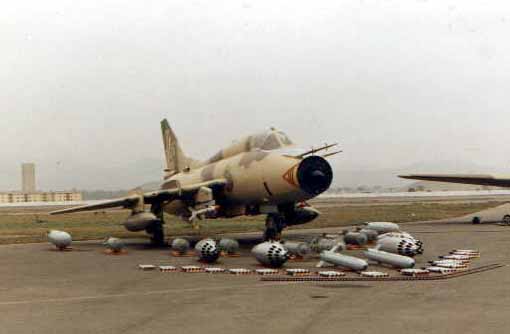
At the beginning of the following year, 19 officers and 56 NCOs of the Fuerza Aérea del Perú -FAP- (Peruvian Air Force), traveled in absolute secrecy to the Military Aeronautical Institute (IMAK) in Krasnoyarsk, to be qualified as operators of the Su-22 system. One of the first to be checked to fly Soviet aircraft was Lieutenant General FAP (R) Luis Abraham Cavallerino who, at the time, was the commanding officer of Grupo 11 (Group 11.) Neither the frigid Eastern European weather, nor the unknown language and customs of the Cossack people were an obstacle for their learning. The pilots had to understand and speak Russian well enough to communicate with the control tower during their daily flights, which took place between 6 in the morning to 6 in the evening.
In June, while the group was still completing their operational conversion in the USSR, large ships were dropping anchor at the Port of Paita, with their secret cargo: The Su-22s and their complement of weapons and equipment. Immediately, and with security provided by Peruvian Army troops, the containers made the four hour road trip to Talara. At their new home, the engineers and technicians from OKB Sukhoi, under the leadership of Colonel Fiedor Nikolay and Major H. Kozhushko as well as the FAP’s maintenance personnel, began the aircraft assembly. The official presentation took place during the morning of July 23, 1977, which included a non-stop flight of two aircraft from Talara to Lima, as part of the activities marking the anniversary of the FAP. The psychological impact on those attending the festivities was enormous to say the least.
The mission layout for the new weapons system was approved on September 20 and included supersonic bombing behind enemy lines and aerial defense with the support of missiles and cannons. The first class of aviators qualified on the Su-22 -trained in Peru- was composed of six 2nd lieutenants, four lieutenants, four captains and four Majors. In 1978 the Escuadrón Aéreo No. 111 (111 Air Squadron) had 32 “Fitter’ qualified pilots, allowing the unit to conduct its first “Impala” exercise, with the participation of the Army and the Navy.
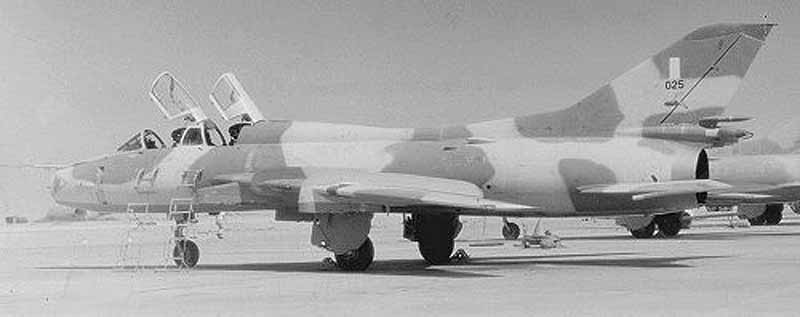
The peruvian government purchased 18 jets more in 1979; these were 16 Su-22M Fitter J (the Su-17M3’s export version) and three two-seater Su-22M Fitter G, which began arriving in the country during the first weeks of the following year. These jets had a bigger “hump”, a Klen-PS telemeter, and were also equipped with a revised tail section, better electronic and aiming equipment and a larger internal fuel capacity. With these aircraft, another unit was formed in May of that year, the Escuadrón Aéreo No. 411 (411 Air Squadron), which was assigned to the even more restricted-access La Joya air base, in Arequipa, 1,000 km South of Lima. Thus, during the following 13 years, the FAP had one squadron of Su-22s at each end of the national territory, enabling the country to respond to two external threats simultaneously.
In Action
After the skirmishes at the “Cordillera Condor-Falso Paquisa” took place in January of 1981, the Su-22s conducted intelligence gathering photo missions, but their participation in combat was dimmed unnecessary. However, on April 24, 1992, there was an incident in which a USAF Lockheed C-130 Hercules, flown by the 310th Transportation Squadron, was detected by the radars at El Pato airbase in Talara. The Hercules was taking part in the operation “Furtive Bear” aimed at secretly photographing the region of the Alto Huallaga. The repeated requests for identification from the local air controllers were met with silence, and shortly after, the airplane began to maneuver in order to leave Peruvian air space.
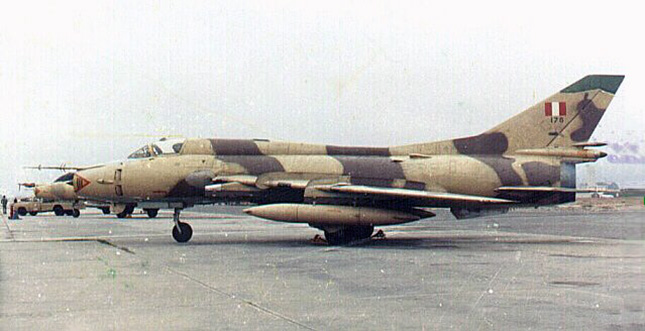
Two Su-22 fighter-bombers were scrambled to intercept the Hercules. Both jets quickly caught up with the lumbering C-130 and tried unsuccessfully to force it to land. The Hercules, deaf to any requests, continued its escape, until the “Fitters” opened fire with their 30 mm cannons, 25 miles from the Pacific Coast. The C-130 was -at last- forced to land at the Piura airfield; regrettably, USAF Sergeant Major Joseph C. Beard Jr. was killed in this action, as he was accidentally ejected from the Hercules while flying at an 18,500 feet.
The conflict on the “Cordillera del Condor”, which took place at the border region with Ecuador in early 1995, found the Peruvian armed forces rather ill-prepared. During the previous 15 years, the peruvian military had focused their efforts on the fight against narcoterrorism. The victory obtained in this internal war had absorbed many of the armed forces resources, which in the case of the FAP, affected the operational level of its aircraft. Within five days however, the experienced Escuadrón the Mantenimiento No. 116 (116 Maintenance Squadron) was able to recondition some twenty Su-22s for crews that in turn, were reinforced by pilots from all the corners of the country. Finally, on January 26, the FAP placed the Primera Region Aérea Territorial or “I-TAR” (First Aerial Territorial Region) on alert, involving personnel and aircraft assigned to the air bases as follows: In Piura the Cessna A-37Bs, in Chiclayo the Mirage M-5P4Ps and the Su-22s in Talara.
The main mission for the Su-22s was to harass enemy emplacements at the Cordillera del Condor, in daylight sorties using FAB-250 bombs. A second order established that as soon as the radars detected an unidentified aircraft crossing the border, the fighter-bombers equipped with BAP-100 runway cratering bombs and cluster bombs, should rush to attack their pre-assigned targets on enemy territory, these usually being advanced airfields.
At 3:30 in the afternoon on February 10, 1995, four “Fitters” assigned to the Chiclayo airbase, took off towards Tiwinza, to conduct a precision attack. The flight took place in relative calm. The first pair of jets dropped their ordnance and began their return maneuver. All of a sudden, a voice called: “Leader, you’re on fire!” According to what other pilots present expressed, and based on the analysis of the remains of one of the Su-22s that was shot down (FAP-014), the aircraft were hit by heavy anti-aircraft artillery fire. This version is contested by pilots of the Ecuadorean Air Force who claim that the Su-22s were shot down by a pair of Mirage F-1s of the 2112 Combat Squadron. In any case, Commander Victor Maldonado Begazo and Major Enrique Caballero managed to eject from their crippled jets. The body of the first was found 15 days later, while from the second, there is no news up to this day.
Desert Sentries
The peruvian Su-22s enjoyed a healthy existence thanks to the untiring efforts of the personnel from Escuadrón de Mantenimiento No. 116, who were in charge of the periodical and non-scheduled inspections, through twelve specialties: Instruments, weaponry, auxiliary equipment, engines, electrical, electronics, photography, structural, radio, gunsights, flight support and hydraulics. In coordination with the Servicio de Mantenimiento -SEMAN- (Maintenance Service) and the Servicio de Electronica -SELEC- (Electronic Service), the 116 Squadron conducted different modifications to the original systems. In 1990 for example, the unit completed the installation of french air-to-air refueling probes on two aircraft. Later on, its mechanics managed to replace the cooling system of the 55VC turbines, thus extending the engine’s service life, and they also replaced the original R-802G radio as well as the ARK-15m automatic radio-compass with their respective western-built equivalents.
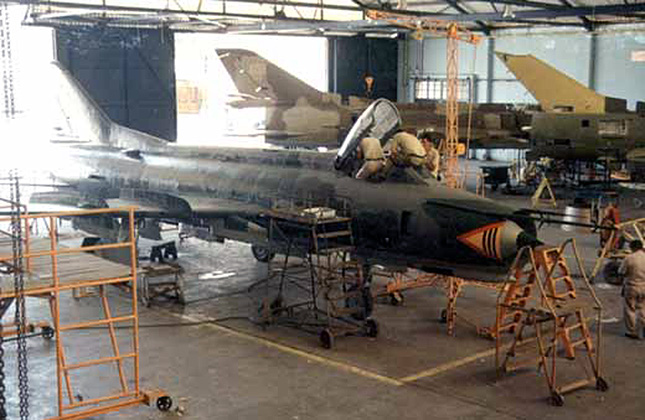
In 1992 VOR / ILS was installed in all the SU-22s, and the automatic wing control was modified for positioning them at 30, 45 and 63 degrees. Between 1994 and 1995, different items for satellite navigation equipment were also installed. After the conflict of Cenepa, the mechanics of the 116 Squadron replaced the emergency braking system indicatorsin all the airplanes, and in 1996 through the “Plan Luciérnaga” the Su-22s were provided with chaff and flare dispensers. One year later, through the “Plan Cuervo” the SPO-10 radar detector was replaced with a more modern warning system, amongst other innovations.
Last, but not least, the 116 Squadron also managed to locally design a series of testing equipment for flight aids, such as the air conditioning timer, engine starters, etc. Two interesting systems were the NAZ-3, a portable hydraulic tester that replaced a device that weighed two tons and was mounted on a ZIL 6×6 truck, and the KPA-6 system that provided electrical current conversion for the start of the engines of the Sukhoi family of aircraft.
Combat Spirit
Upon being assigned to Grupo 11, aviators with previous experience on the Cessna A-37B had to take a ground school for 30 days, to become familiarized with Su-22s. Then they had to fly ten “pre-solo” missions on the “Fitter-G” twin seater in order to obtain the qualification of “Piloto en Capacitación Operativa” (Pilot in Operational Qualification.) These missions included formation flight, nocturnal flight, instrument flight, attack sorties, etc. One hundred flying hours were needed to reach the level of “Operational Pilot”, after which, with different number of hours and experience, came the ratings of “Test Pilot” and finally, “Instructor Pilot.”
Once a year, the pilots traveled to the Russian Federation, to receive instruction in the KTC-13 flight simulator, at the IMAK base in Krasnoyarsk. Together with their colleagues from Angola, Uzbekistan and Tajikistan, the Peruvians received detailed instruction from the veteran Soviet era pilots. Later, they participated in operational deployments with the Peruvian Navy, as part of the UNITAS exercises sponsored by the USA, as well as during the “Open Houses” organized by the FAP.
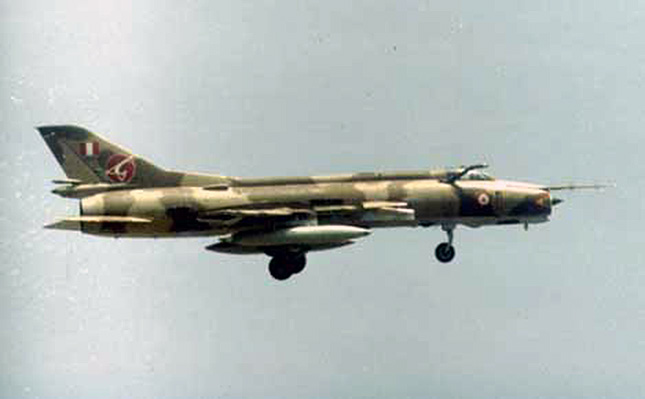
Although the Su-22 retirement from service had been programmed for “beyond 2010”, the ever decreasing military budget made it a natural candidate for deactivation. The type’s fate at last was sealed by the crash -in mid-2006- of one of the last operational SU-22M. The FAP high command took advantage of this circumstance and in June, decreed the preventive grounding of the fleet, for a full systems revision. By September, orders were received to suspend all activities related to the Su-22s with the exception of preservation work for the last 12 aircraft assigned to the Escuadrón Aéreo No. 111. Shortly after, the Sukhoi Su-22 weapons system was put into “reserve” status through a disposition from the Comando de Operaciones de la Fuerza Aérea del Perú (The Peruvian Air Force’s Operations Command.)
After thirty years of service, almost 40,000 flight hours, 61 of them in combat, and approximately 150 qualified pilots, the Su-22 was the most emblematic combat airplane of the Peruvian Air Force. With its deactivation, a great chapter of the peruvian military aviation history came to a sad end.

